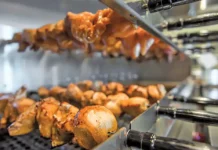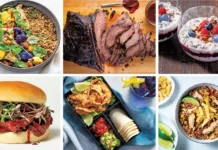
Bubble? Downturn?? Correction?! Really? The Dow and NASDAQ have reached new highs – unemployment is very low and continues to go down. Interest rates are low and the housing market has turned hot again, so what does this all mean for the foodservice industry, the economy and for the future?
The Wall Street Journal recently reported that “the U.S. restaurant industry is in a funk” despite other sectors of the economy growing. Seismic shifts in lifestyle, income, shopping habits, confidence in the future have started to take hold and the first place this impacts is often the restaurant industry.
[pro_ad_display_adzone id=”9252″]
Everyone I talk to in the financial world is certain that a “correction” is coming, but they aren’t sure when. Investors are only considering businesses that can perform or survive the proverbial “down cycle”, which isn’t looking particularly great for the foodservice industry these days. And all the money guys are looking for those “leading economic indicators” that will tell them if and when this downslide will begin. I think I have found one.
Restaurants have always been looked upon as the canary in the coalmine and a “leading indicator” of what is to come in the rest of the economy. Disruptive changes to many companies and their business models add to uncertainty. As a result we are seeing major shifts in dining habits emerging. Income inequality is a real issue. This amplifies evidence that the deep declines within moderately priced casual theme restaurants is signaling trouble ahead. Amongst the hardest hit are brands like Applebee’s, Ruby Tuesday’s and Chili’s. These high value populist brands are in a serious decline. QSR concepts are doing better, but still reporting negative numbers.
The most telling numbers for me are very tightly focused – LUNCH! No dining segment has taken a bigger beating than lunch over the past 18 months. There are a wide variety of reasons contributing to this massive downslide, but they all tell me that the underlying economic drivers are miss firing signaling greater macroeconomic changes than we anticipated. Many of the restaurants that rely on lunch sales may go the way of the storefront retailers now struggling to stay relevant or even alive in this changing world. Slowed income growth; income inequality and the disruptive effects of automation (i.e. displacing thousands of workers in the name of efficiency) is causing unrest in the markets and the workforce. Lunch sales are driven by this machine.
According to market-research firm NPD Group Inc., in 2016 – 433 million fewer trips were made to US restaurants at lunchtime than in 2015, resulting in roughly $3.2 billion in lost business. This is the lowest level of lunch traffic in 40 years. This is huge!
There is a lot of turmoil in this country and the world. People are protecting their pocketbooks and working hard just incase of an economic downturn. Even Execs aren’t doing the two Martini “Power Lunch” anymore. The ritual of building strong personal relationships with business partners for long term gain, has given way to non-meal related meetings, conference calls or Skype. Millennials just communicate on electronic or social media. The dynamic is completely changing.
Some big shifts in work behavior also are at play. More and more people are doing all or a portion of their workweek at home. These telecommuters are highly unlikely to go out and eat lunch the way they did if they went to the office. It is now estimated that over 24% of office workers do a portion of their workweek from home.
On the leisure front, the dominance of online shopping has driven people away from brick and mortar stores, malls and downtown storefronts, catastrophically crushing an entire sector of the traditional economy. Fewer trips to the mall or to your local Main Street means fewer walk-in dining opportunities for shoppers wanting to grab lunch while they are out and about. E-commerce has pounded the brick and mortar retailers to death – are restaurants suffering collateral damage?
The NPD Group also reported that higher cost of restaurant lunches is another factor in the decline. Lunch tabs in restaurants have gone up significantly while food costs in supermarkets have gone down. People notice. Supermarkets like Whole Foods and others have long positioned themselves as direct competitors to restaurants for all prepared meals by providing variety, quality and value. Now their high-priced consumer perceptions have fallen below restaurant dining costs. Middle to lower income employees feel cash strapped and are struggling to stay afloat, save, pay down college debt or plan for retirement. It’s a no brainer for them to pack a lunch and eat at their desk.
In the struggle to provide a living wage to employees, restaurants have become stressed and with labor costs rising and adding to the woes. Unemployment goes down and the overall labor market tightens which drives up wages for restaurant workers. Prices must go up to compensate and lunch is one of the most sensitive segments. In Seattle, it was determined that menu prices rose between 7% and 9% after the city increased the minimum wage to $12.50. The economic conditions require restaurateurs to provide workers with a living wage in order to retain them. This conflicts directly with the consumer side, which does not want to invest the money, energy or time into eating a more expensive lunch.
Restaurant owners have tried to adapt in reaction to this shift in the segment, because maintaining an empty dining room during lunch can be very costly. A restaurateur pays rent for the space 24 hours a day – 7 days a week regardless if it is filled or not.
The pain is spreading to suppliers. Meat giant Tyson Foods Inc. recently said a 29% drop in quarterly earnings was due partly to the decline in restaurant traffic, much of which can be tracked to the declining lunch sector. Produces, distributors, resellers, retailers, restaurants, each of which provide jobs and returns to their shareholders will suffer. Indirectly, this micro economic recession spills over onto everyone doing business with these restaurants and their vendors.
The steep and measurable decline in lunch sales is not merely a call to react to market changes. It is a real sign of things to come. It is a light cast on a paradigm shift in our industry and the overall economy. If you are listening, the canary just stopped tweeting. You should be prepared to adapt and change your business model or you might have really difficult financial challenges ahead.
“It is not the strongest of the species that survives, nor the most intelligent, but the one that is most responsive to change.” – Charles Darwin 1809
 If you’d like to discuss strategies or other financial issues facing your business please contact me at dsederholt@sfscapital.com.
If you’d like to discuss strategies or other financial issues facing your business please contact me at dsederholt@sfscapital.com.
























Comments are closed.